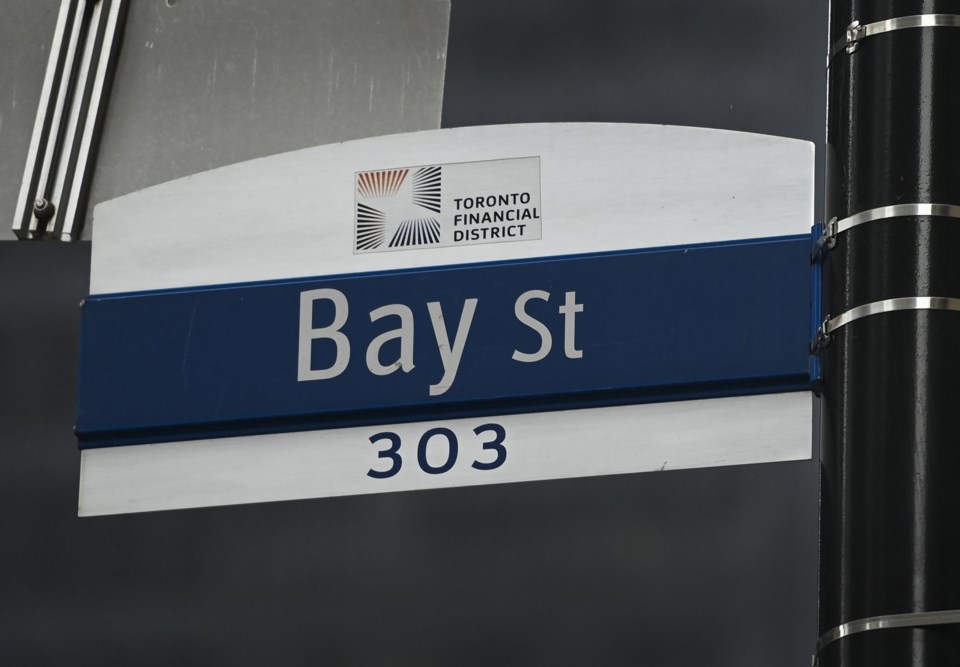TORONTO — Gains in energy stocks and base metals led Canada's main stock index up almost 300 points in a broad-based rally Wednesday, while major tech names led a rally on U.S. stock markets, and the U.S. Federal Reserve held its key interest rate steady.
The S&P/TSX composite index closed up 286.14 points, or 1.3 per cent, at 23,110.81.
In New York, the Dow Jones industrial average was up 99.46 points or 0.2 per cent at 40,842.79. The S&P 500 index was up 85.86 points or 1.6 per cent at 5,522.30, while the Nasdaq composite was up 451.98 points or 2.6 per cent at 17,599.40.
The last day of July brought a reversal in a tepid month for tech, after the sector drove markets for the first half of the year, said Brian Madden, chief investment officer with First Avenue Investment Counsel.
“The tone of market action in July has been kind of a 180-degree reversal in the thematic leadership that prevailed through the first six months of the year,” said Madden.
“That has kind of reinvigorated itself.”
Nvidia, the poster child for the tech rally, gained almost 13 per cent.
The company was likely boosted by a strong earnings report the evening before from its semiconductor peer Advanced Micro Devices, said Madden.
Microsoft’s earnings report Tuesday likely also helped, he added — though the overall report was mixed, a big capital expenditures bill was “a good sign for semis.”
Wednesday also brought the latest interest rate decision from the U.S. Federal Reserve. The central bank held its key rate steady as expected, but Madden said its statement leaned a little on the dovish side.
Fed chairman Jerome Powell said central bank officials are “getting closer to the point” where they will be comfortable cutting interest rates.
Markets have already priced in a first cut for September.
More economic data Wednesday also helped boost confidence of a rate cut in the U.S. as pay and benefits grew more slowly in the most recent quarter.
North of the border, the TSX saw a broad-based rally, with tech stocks running hot, and utilities, materials and energy also going strong.
The market seems to be “piggybacking on this idea that we've got rate cuts already in Canada, we're going to have more, and the U.S. is going to be joining the party, probably, in six weeks’ time,” said Madden.
Canada’s GDP report showed the economy grew 0.2 per cent in May, while Statistics Canada estimated that real gross domestic product grew at an annualized rate of 2.2 per cent in the second quarter.
While the report did not come as a shock, it helps validate continued expectations that the Bank of Canada will keep cutting in 2024, said Madden.
Oil prices rose more than four per cent on Wednesday, and the TSX’s energy index was up more than three per cent.
Oil prices were likely pushed higher by geopolitical tensions in the Middle East, said Madden, as well as by lower U.S. crude oil inventories.
Hamas’ top political leader was killed earlier in the day by an airstrike in Iran, as Israel’s war in Gaza approaches its 300th day, prompting worries about the flow of crude oil in the Middle East.
The September crude oil contract was up US$3.18 at US$77.91 per barrel and the September natural gas contract was down nine cents at US$2.04 per mmBTU.
The December gold contract was up US$21.10 at US$2,473.00 an ounce and the September copper contract was up 10 cents at US$4.18 a pound.
The Canadian dollar traded for 72.42 cents US compared with 72.20 cents US on Tuesday.
— With files from The Associated Press
This report by The Canadian Press was first published July 31, 2024.
Companies in this story: (TSX:GSPTSE, TSX:CADUSD)
Rosa Saba, The Canadian Press




